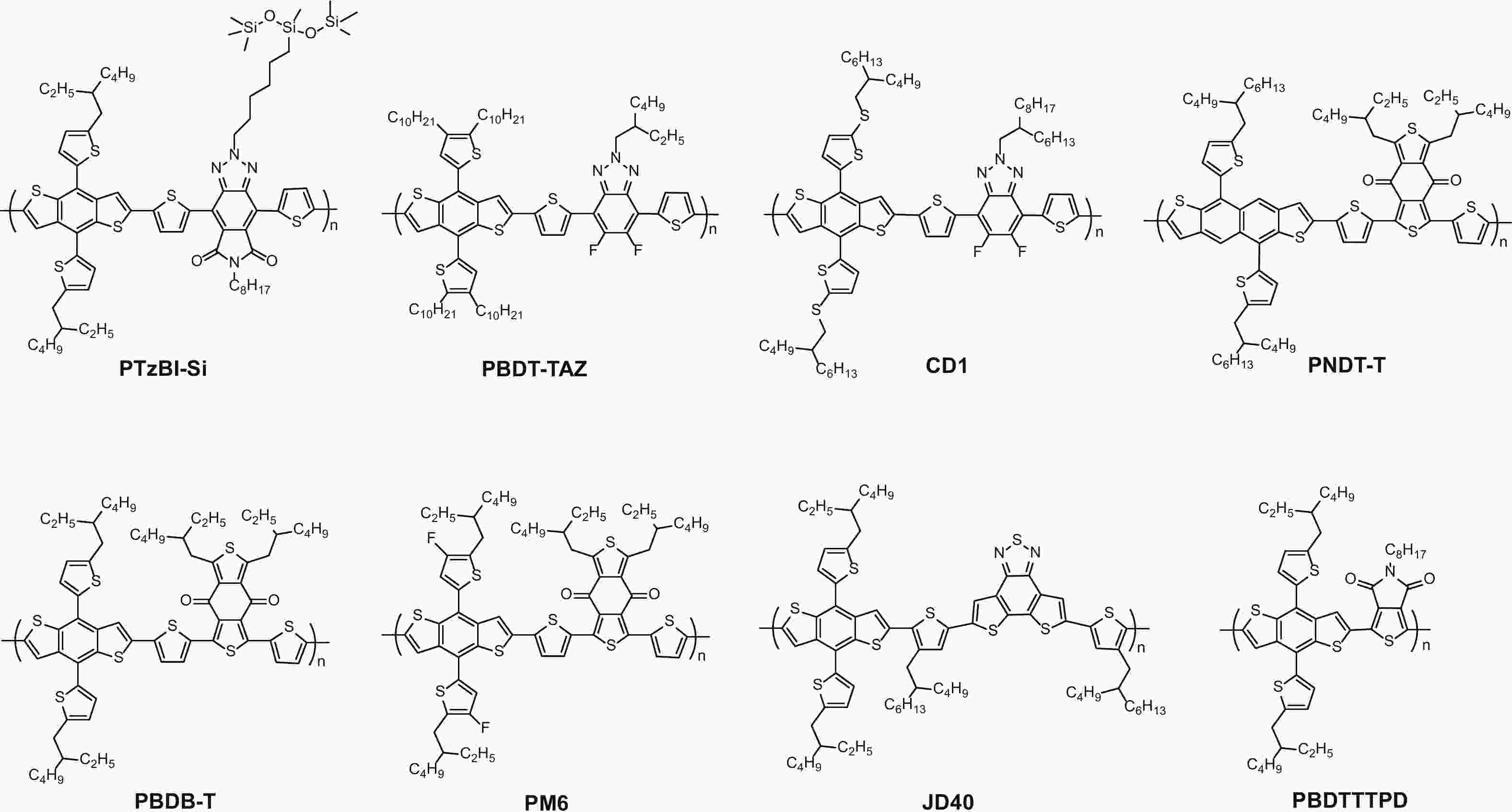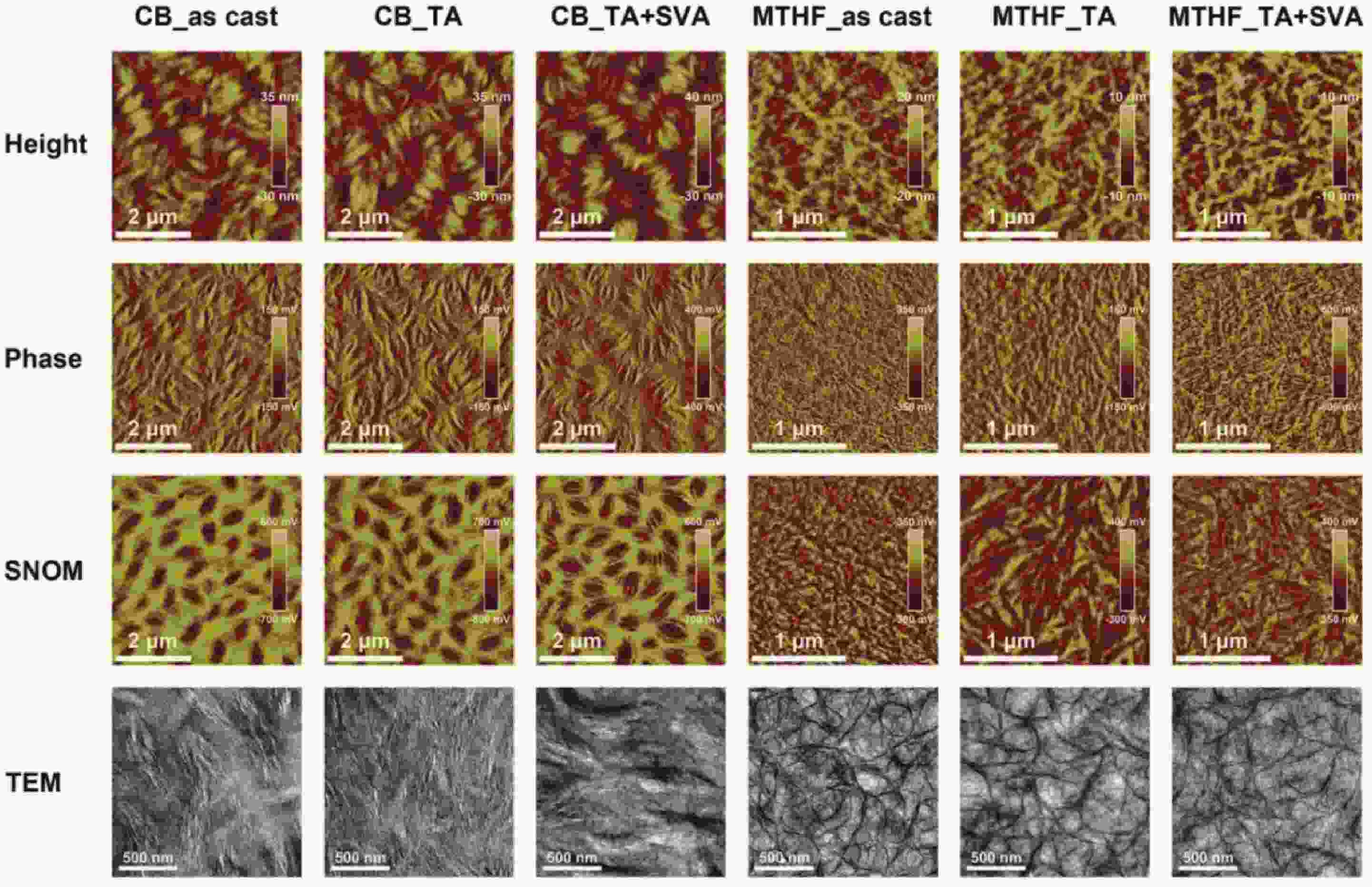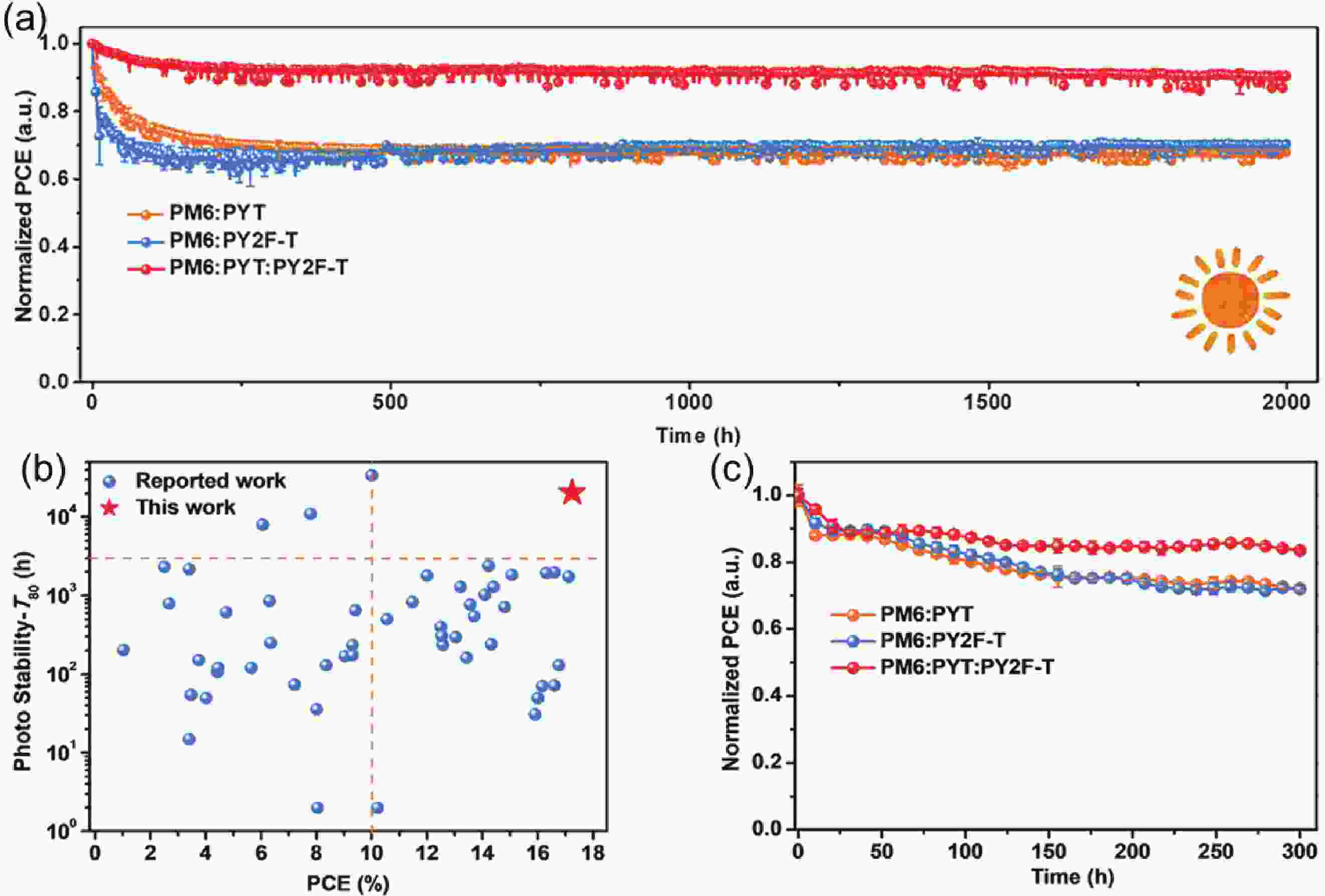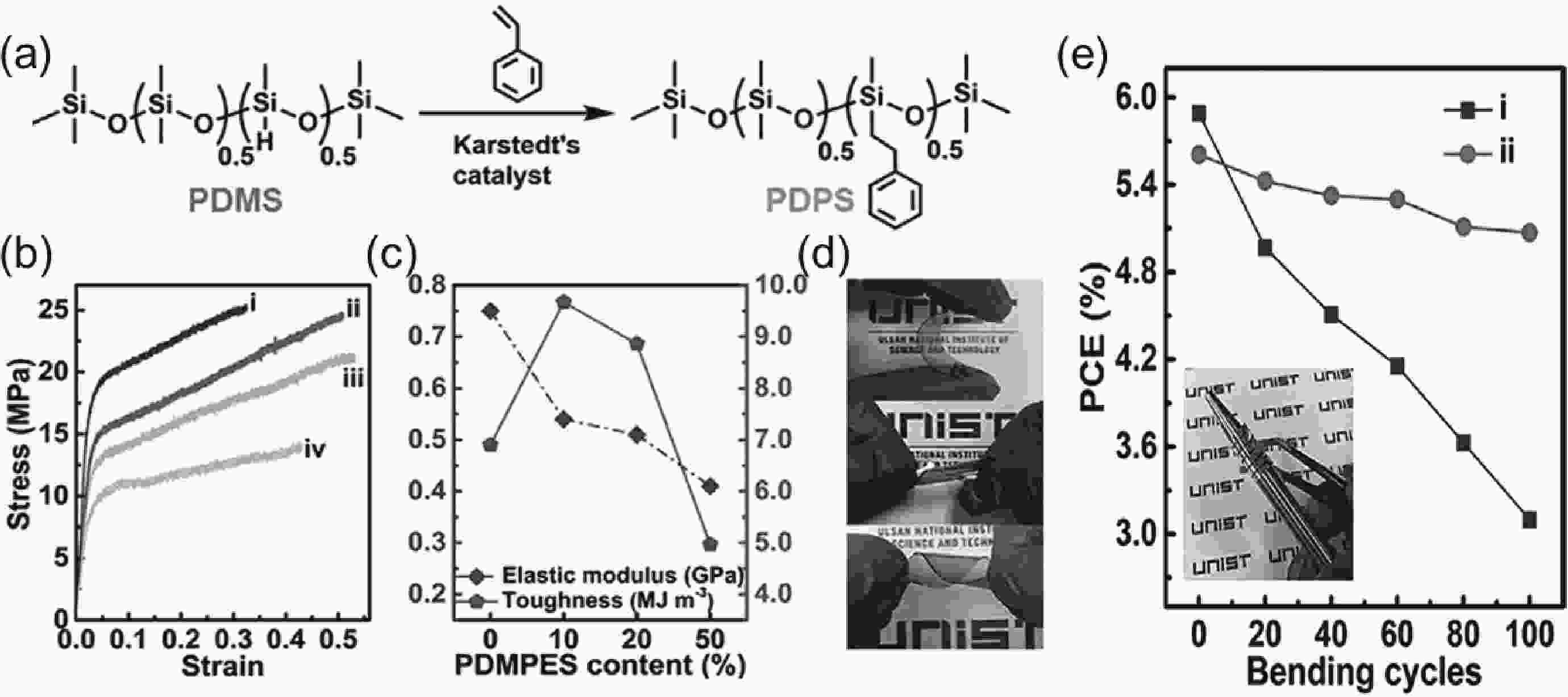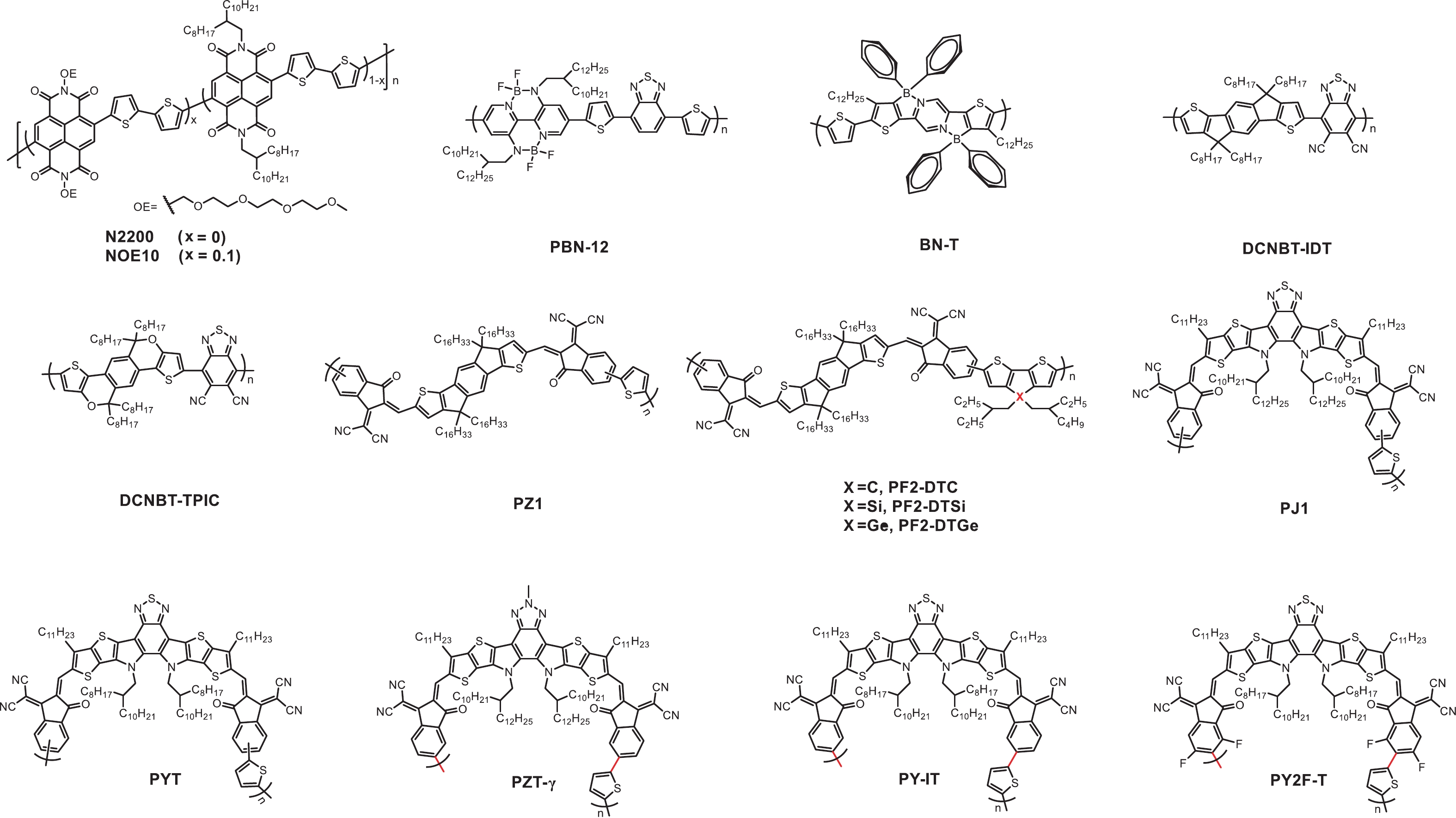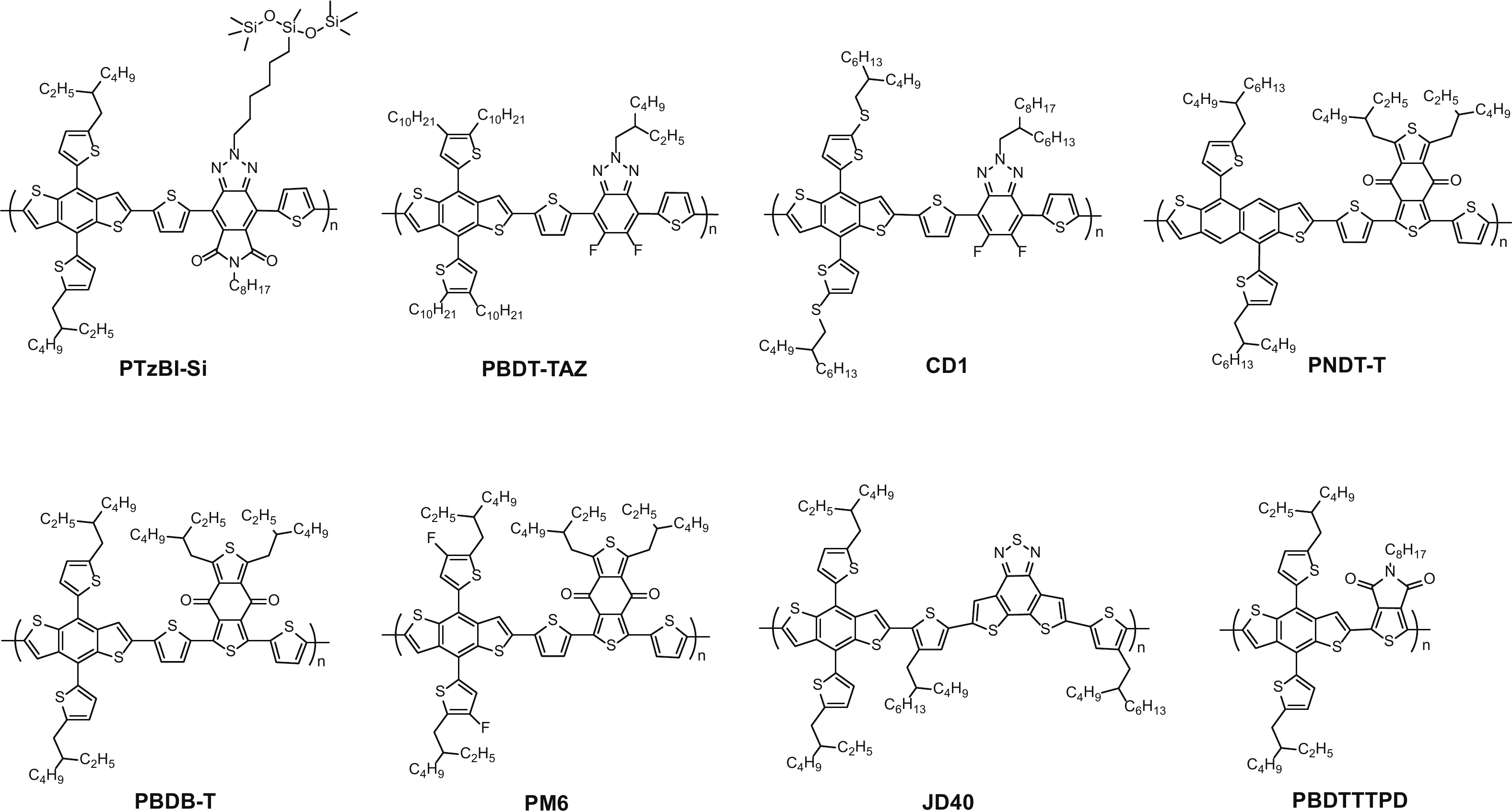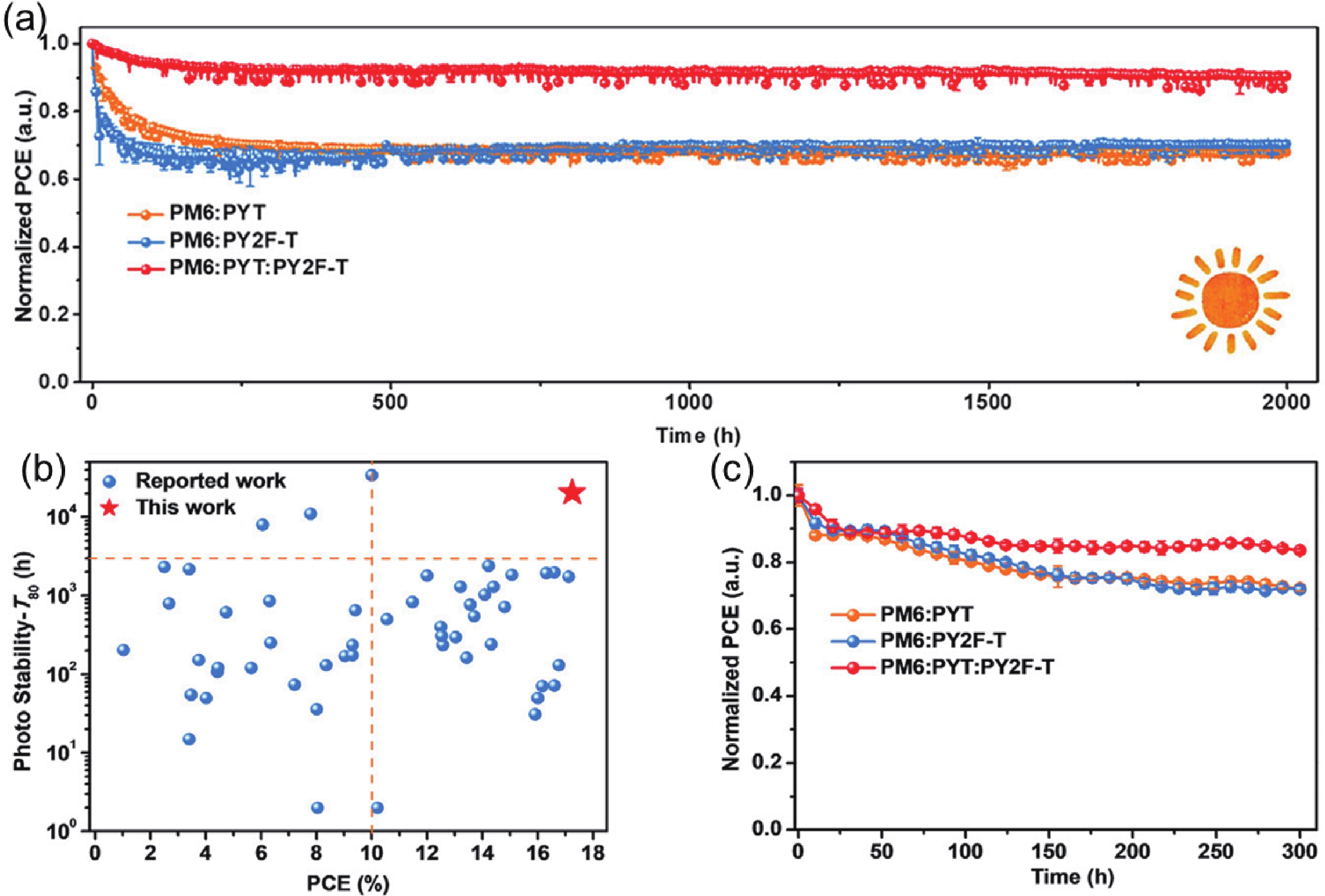| Citation: |
Baoqi Wu, Bingyan Yin, Chunhui Duan, Liming Ding. All-polymer solar cells[J]. Journal of Semiconductors, 2021, 42(8): 080301. doi: 10.1088/1674-4926/42/8/080301
B Q Wu, B Y Yin, C H Duan, L M Ding, All-polymer solar cells[J]. J. Semicond., 2021, 42(8): 080301. doi: 10.1088/1674-4926/42/8/080301.
Export: BibTex EndNote
|
-
References
[1] Liu Q, Jiang Y, Jin K, et al. 18% efficiency organic solar cells. Sci Bull, 2020, 65, 272 doi: 10.1016/j.scib.2020.01.001[2] Lin Y, Firdaus Y, Isikgor F H, et al. Self-assembled monolayer enables hole transport layer-free organic solar cells with 18% efficiency and improved operational stability. ACS Energy Lett, 2020, 5, 2935 doi: 10.1021/acsenergylett.0c01421[3] Lin Y, Nugraha M I, Firdaus Y, et al. A simple n-dopant derived from diquat boosts the efficiency of organic solar cells to 18.3%. ACS Energy Lett, 2020, 5, 3663 doi: 10.1021/acsenergylett.0c01949[4] Zhang M, Zhu L, Zhou G, et al. Single-layered organic photovoltaics with double cascading charge transport pathways: 18% efficiencies. Nat Commun, 2021, 12, 309 doi: 10.1038/s41467-020-20580-8[5] Zhan L, Li S, Xia X, et al. Layer-by-layer processed ternary organic photovoltaics with efficiency over 18%. Adv Mater, 2021, 33, 2007231 doi: 10.1002/adma.202007231[6] Lin Y, Magomedov A, Firdaus Y, et al. 18.4% organic solar cells using a high ionization energy self-assembled monolayer as hole extraction interlayer. ChemSusChem, 2021, in press doi: 10.1002/cssc.202100707[7] Lee C, Lee S, Kim G U, et al. Recent advances, design guidelines, and prospects of all-polymer solar cells. Chem Rev, 2019, 119, 8028 doi: 10.1021/acs.chemrev.9b00044[8] Sun R, Wang W, Yu H, et al. Achieving over 17% efficiency of ternary all-polymer solar cells with two well-compatible polymer acceptors. Joule, 2021, 5, 1548 doi: 10.1016/j.joule.2021.04.007[9] Liu T, Yang T, Ma R, et al. 16% efficiency all-polymer organic solar cells enabled by a finely tuned morphology via the design of ternary blend. Joule, 2021, 5, 914 doi: 10.1016/j.joule.2021.02.002[10] Ma R, Yu J, Liu T, et al. All-polymer solar cells with over 16% efficiency and enhanced stability enabled by compatible solvent and polymer additives. Aggregate, 2021, in press doi: 10.1002/agt2.58[11] Jia T, Zhang J, Zhang K, et al. All-polymer solar cells with efficiency approaching 16% enabled using a dithieno[3',2': 3,4;2",3": 5,6]benzo[1,2c][1,2,5]thiadiazole (fDTBT)-based polymer donor. J Mater Chem A, 2021, 9, 8975 doi: 10.1039/D1TA00838B[12] Fu H, Li Y, Yu J, et al. High efficiency (15.8%) all-polymer solar cells enabled by a regioregular narrow bandgap polymer acceptor. J Am Chem Soc, 2021, 143, 2665 doi: 10.1021/jacs.0c12527[13] Duan C, Ding L. The new era for organic solar cells: polymer acceptors. Sci Bull, 2020, 65, 1508 doi: 10.1016/j.scib.2020.05.023[14] Yang J, Xiao B, Tang A, et al. Aromatic-diimide-based n-type conjugated polymers for all-polymer solar cell applications. Adv Mater, 2019, 31, 1804699 doi: 10.1002/adma.201804699[15] Genene Z, Mammo W, Wang E, et al. Recent advances in n-type polymers for all-polymer solar cells. Adv Mater, 2019, 31, 1807275 doi: 10.1002/adma.201807275[16] Wang G, Melkonyan F S, Facchetti A, et al. All-polymer solar cells: recent progress, challenges, and prospects. Angew Chem Int Ed, 2019, 58, 4129 doi: 10.1002/anie.201808976[17] Sun H, Wang L, Wang Y, et al. Imide-functionalized polymer semiconductors. Chem Eur J, 2019, 25, 87 doi: 10.1002/chem.201803605[18] Shi Q, Wu J, Wu X, et al. Perylene diimide-based conjugated polymers for all-polymer solar cells. Chem Eur J, 2020, 26, 12510 doi: 10.1002/chem.202001011[19] Gao L, Zhang Z G, Xue L, et al. All-polymer solar cells based on absorption-complementary polymer donor and acceptor with high power conversion efficiency of 8.27%. Adv Mater, 2016, 28, 1884 doi: 10.1002/adma.201504629[20] Fan B, Ying L, Wang Z, et al. Optimisation of processing solvent and molecular weight for the production of green-solvent-processed all-polymer solar cells with a power conversion efficiency over 9%. Energy Environ Sci, 2017, 10, 1243 doi: 10.1039/C7EE00619E[21] Liu X, Zou Y, Wang H Q, et al. High-performance all-polymer solar cells with a high fill factor and a broad tolerance to the donor/acceptor ratio. ACS Appl Mater Interfaces, 2018, 10, 38302 doi: 10.1021/acsami.8b15028[22] Zhu L, Zhong W, Qiu C, et al. Aggregation-induced multilength scaled morphology enabling 11.76% efficiency in all-polymer solar cells using printing fabrication. Adv Mater, 2019, 31, 1902899 doi: 10.1002/adma.201902899[23] Yan H, Chen Z, Zheng Y, et al. A high-mobility electron-transporting polymer for printed transistors. Nature, 2009, 457, 679 doi: 10.1038/nature07727[24] Lee J W, Sung M J, Kim D, et al. Naphthalene diimide-based terpolymers with controlled crystalline properties for producing high electron mobility and optimal blend morphology in all-polymer solar cells. Chem Mater, 2020, 32, 2572 doi: 10.1021/acs.chemmater.0c00055[25] Wu Y, Schneider S, Walter C, et al. Fine-tuning semiconducting polymer self-aggregation and crystallinity enables optimal morphology and high-performance printed all-polymer solar cells. J Am Chem Soc, 2020, 142, 392 doi: 10.1021/jacs.9b10935[26] Lee J W, Choi N, Kim D, et al. Side chain engineered naphthalene diimide-based terpolymer for efficient and mechanically robust all-polymer solar cells. Chem Mater, 2021, 33, 1070 doi: 10.1021/acs.chemmater.0c04721[27] Tran D K, Kolhe N B, Hwang Y J, et al. Effects of a fluorinated donor polymer on the morphology, photophysics, and performance of all-polymer solar cells based on naphthalene diimide-arylene copolymer acceptors. ACS Appl Mater Interfaces, 2020, 12, 16490 doi: 10.1021/acsami.0c01382[28] Li Z, Ying L, Zhu P, et al. A generic green solvent concept boosting the power conversion efficiency of all-polymer solar cells to 11%. Energy Environ Sci, 2019, 12, 157 doi: 10.1039/C8EE02863J[29] Liu X, Li X, Wang L, et al. Synergistic effects of the processing solvent and additive on the production of efficient all-polymer solar cells. Nanoscale, 2020, 12, 4945 doi: 10.1039/C9NR10495J[30] Seo S, Kim J, Kang H, et al. Polymer donors with temperature-insensitive, strong aggregation properties enabling additive-free, processing temperature-tolerant high-performance all-polymer solar cells. Macromolecules, 2020, 54, 53 doi: 10.1021/acs.macromol.0c02496[31] Xie B, Zhang K, Hu Z, et al. Polymer pre-aggregation enables optimal morphology and high performance in all-polymer solar cells. Sol RRL, 2019, 4, 1900385 doi: 10.1002/solr.201900385[32] Zhang Y, Xu Y, Ford M J, et al. Thermally stable all-polymer solar cells with high tolerance on blend ratios. Adv Energy Mater, 2018, 8, 1800029 doi: 10.1002/aenm.201800029[33] Kim M, Kim H I, Ryu S U, et al. Improving the photovoltaic performance and mechanical stability of flexible all-polymer solar cells via tailoring intermolecular interactions. Chem Mater, 2019, 31, 5047 doi: 10.1021/acs.chemmater.9b00639[34] Liu X, Zhang C, Duan C, et al. Morphology optimization via side chain engineering enables all-polymer solar cells with excellent fill factor and stability. J Am Chem Soc, 2018, 140, 8934 doi: 10.1021/jacs.8b05038[35] Dou C, Ding Z, Zhang Z, et al. Developing conjugated polymers with high electron affinity by replacing a C-C unit with a B←N unit. Angew Chem Int Ed, 2015, 54, 3648 doi: 10.1002/anie.201411973[36] Li Y, Meng H, Liu T, et al. 8.78% efficient all-polymer solar cells enabled by polymer acceptors based on a B←N embedded electron-deficient unit. Adv Mater, 2019, 31, 1904585 doi: 10.1002/adma.201904585[37] Zhao R, Wang N, Yu Y, et al. Organoboron polymer for 10% efficiency all-polymer solar cells. Chem Mater, 2020, 32, 1308 doi: 10.1021/acs.chemmater.9b04997[38] Shi S, Chen P, Chen Y, et al. A narrow-bandgap n-type polymer semiconductor enabling efficient all-polymer solar cells. Adv Mater, 2019, 31, 1905161 doi: 10.1002/adma.201905161[39] Feng K, Huang J, Zhang X, et al. High-performance all-polymer solar cells enabled by n-type polymers with an ultranarrow bandgap down to 1.28 eV. Adv Mater, 2020, 32, 2001476 doi: 10.1002/adma.202001476[40] Zhao R, Liu J, Wang L. Polymer acceptors containing B←N units for organic photovoltaics. Acc Chem Res, 2020, 53, 1557 doi: 10.1021/acs.accounts.0c00281[41] Xu X, Feng K, Yu L, et al. Highly efficient all-polymer solar cells enabled by p-doping of the polymer donor. ACS Energy Lett, 2020, 5, 2434 doi: 10.1021/acsenergylett.0c01010[42] Zhang Z G, Yang Y, Yao J, et al. Constructing a strongly absorbing low-bandgap polymer acceptor for high-performance all-polymer solar cells. Angew Chem Int Ed, 2017, 56, 13503 doi: 10.1002/anie.201707678[43] Jia T, Zhang J, Zhong W, et al. 14.4% efficiency all-polymer solar cell with broad absorption and low energy loss enabled by a novel polymer acceptor. Nano Energy, 2020, 72, 104718 doi: 10.1016/j.nanoen.2020.104718[44] Zhang Z G, Li Y. Polymerized small-molecule acceptors for high-performance all-polymer solar cells. Angew Chem Int Ed, 2021, 60, 4422 doi: 10.1002/anie.202009666[45] Meng Y, Wu J, Guo X, et al. 11.2% efficiency all-polymer solar cells with high open-circuit voltage. Sci China Chem, 2019, 62, 845 doi: 10.1007/s11426-019-9466-6[46] Peng F, An K, Zhong W, et al. A universal fluorinated polymer acceptor enables all-polymer solar cells with > 15% efficiency. ACS Energy Lett, 2020, 5, 3702 doi: 10.1021/acsenergylett.0c02053[47] Sun H, Yu H, Shi Y, et al. A narrow-bandgap n-type polymer with an acceptor-acceptor backbone enabling efficient all-polymer solar cells. Adv Mater, 2020, 32, 2004183 doi: 10.1002/adma.202004183[48] Fan Q, An Q, Lin Y, et al. Over 14% efficiency all-polymer solar cells enabled by a low bandgap polymer acceptor with low energy loss and efficient charge separation. Energy Environ Sci, 2020, 13, 5017 doi: 10.1039/D0EE01828G[49] Su N, Ma R, Li G, et al. High-efficiency all-polymer solar cells with poly-small-molecule acceptors having π-extended units with broad near-IR absorption. ACS Energy Lett, 2021, 6, 728 doi: 10.1021/acsenergylett.1c00009[50] Wang H, Chen H, Xie W, et al. Configurational isomers induced significant difference in all-polymer solar cells. Adv Funct Mater, 2021, 31, 2100877 doi: 10.1002/adfm.202100877[51] Wang W, Wu Q, Sun R, et al. Controlling molecular mass of low-band-gap polymer acceptors for high-performance all-polymer solar cells. Joule, 2020, 4, 1070 doi: 10.1016/j.joule.2020.03.019[52] Zhang L, Jia T, Pan L, et al. 15.4% efficiency all-polymer solar cells. Sci China Chem, 2021, 64, 408 doi: 10.1007/s11426-020-9935-2[53] Yu H, Qi Z, Yu J, et al. Fluorinated end group enables high-performance all-polymer solar cells with near-infrared absorption and enhanced device efficiency over 14%. Adv Energy Mater, 2020, 11, 2003171 doi: 10.1002/aenm.202003171[54] Wu Q, Wang W, Wu Y, et al. High-performance all-polymer solar cells with a pseudo-bilayer configuration enabled by a stepwise optimization strategy. Adv Funct Mater, 2021, 31, 2010411 doi: 10.1002/adfm.202010411[55] Yu H, Pan M, Sun R, et al. Regio-regular polymer acceptors enabled by determined fluorination on end groups for all-polymer solar cells with 15.2% efficiency. Angew Chem Int Ed, 2021, 60, 10137 doi: 10.1002/anie.202016284[56] Luo Z, Liu T, Ma R, et al. Precisely controlling the position of bromine on the end group enables well-regular polymer acceptors for all-polymer solar cells with efficiencies over 15%. Adv Mater, 2020, 32, 2005942 doi: 10.1002/adma.202005942[57] Zhu X, Hu L, Wang W, et al. Reversible chemical reactivity of non-fullerene acceptors for organic solar cells under acidic and basic environment. ACS Appl Energy Mater, 2019, 2, 7602 doi: 10.1021/acsaem.9b01591[58] Guo J, Wu Y, Sun R, et al. Suppressing photo-oxidation of non-fullerene acceptors and their blends in organic solar cells by exploring material design and employing friendly stabilizers. J Mater Chem A, 2019, 7, 25088 doi: 10.1039/C9TA09961A[59] Lv R, Geng S, Li S, et al. Influences of quinoid structures on stability and photovoltaic performance of nonfullerene acceptors. Sol RRL, 2020, 4, 2000286 doi: 10.1002/solr.202000286[60] Liu H, Wang W, Zhou Y, et al. A ring-locking strategy to enhance the chemical and photochemical stability of A–D–A-type non-fullerene acceptors. J Mater Chem A, 2021, 9, 1080 doi: 10.1039/D0TA09924D[61] McNeill C R. Morphology of all-polymer solar cells. Energy Environ Sci, 2012, 5, 5653 doi: 10.1039/c2ee03071c[62] Xu Y, Yuan J, Liang S, et al. Simultaneously improved efficiency and stability in all-polymer solar cells by a P–i–N architecture. ACS Energy Lett, 2019, 4, 2277 doi: 10.1021/acsenergylett.9b01459[63] Li N, McCulloch I, Brabec C J. Analyzing the efficiency, stability and cost potential for fullerene-free organic photovoltaics in one figure of merit. Energy Environ Sci, 2018, 11, 1355 doi: 10.1039/C8EE00151K[64] Kim T, Kim J H, Kang T E, et al. Flexible, highly efficient all-polymer solar cells. Nat Commun, 2015, 6, 8547 doi: 10.1038/ncomms9547[65] Chen S, Jung S, Cho H J, et al. Highly flexible and efficient all-polymer solar cells with high-viscosity processing polymer additive toward potential of stretchable devices. Angew Chem Int Ed, 2018, 57, 13277 doi: 10.1002/anie.201807513[66] Fan Q, Su W, Chen S, et al. Mechanically robust all-polymer solar cells from narrow band gap acceptors with hetero-bridging atoms. Joule, 2020, 4, 658 doi: 10.1016/j.joule.2020.01.014 -
Proportional views






 DownLoad:
DownLoad:
